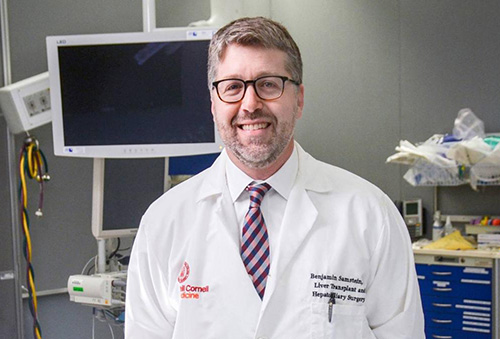The Center for Liver Disease and Transplantation at NewYork-Presbyterian continues at the forefront of progress in liver transplantation with major inroads achieved in minimally invasive living donor liver transplantation. In addition to wide-ranging research initiatives, the Center provides comprehensive care from a team of transplant specialists – hepatologists, liver transplant specialists, gastroenterologists, hepatobiliary surgeons – who work collaboratively to promote the best possible outcomes for the recipient and the safest surgery for the donor. The depth of the program’s clinical and research expertise continually results in one of the highest success rates and shortest wait times for liver transplants in the New York metropolitan area and nationwide, as well as a lower waitlist mortality and excellent post-transplant survival outcomes.

Dr. Benjamin Samstein
Benjamin Samstein, MD, is Chief of Liver Transplantation and Hepatobiliary Surgery at NewYork-Presbyterian/
Making Headway in Living Donor Liver Transplant
The Living Donor Liver Transplantation Program at NewYork-Presbyterian has one of the highest cumulative volumes. The faculty have pioneered and continue to hone the procedure for pediatric and adult patients with serious liver disease and are among the most experienced in the country. In recent years, Dr. Samstein and his colleagues have been particularly focused on expanding the role of minimally invasive donor hepatectomy (MIDH). In fact, Dr. Samstein was one of 12 international experts in MIDH who came together to develop clinical guidelines needed for the evolving and increasingly performed procedure for living donor liver transplantation. Sponsored by the International Laparoscopic Liver Society and the Asian-Pacific Hepato-Pancreato-Biliary Association, the Expert Consensus Guidelines initiative was organized with the goal of “safe implementation and development of these complex techniques with donor safety as the main priority.”
“I think of living donation as a strategy for getting people transplanted by providing immediate organ availability and avoiding long waits for scarce donor organs,” says Dr. Samstein. “However, one of the barriers to living donation is that patients feel uncomfortable asking family or friends out of concern for the impact the donation might have on their loved ones. Part of what we're trying to do is minimize that impact in order to facilitate more liver transplants and allow people suffering from end-stage liver disease to survive a very challenging condition. In recent years there has been much discussion about what technologies would be helpful for making minimally invasive liver surgery more likely to be successful and easier on donors.”
I think of living donation as a strategy for getting people transplanted by providing immediate organ availability and avoiding long waits for scarce donor organs.
— Dr. Benjamin Samstein
According to Dr. Samstein, fluorescence image-guided surgery – one of the more recent advances in laparoscopic and robotic surgery – has become a powerful tool for enhanced safety of minimally invasive liver surgery. “Infrared fluorescence cholangiography is a novel non-invasive method for real-time, radiation free, intraoperative biliary mapping and is a safe and effective advancement for identifying biliary anatomy,” notes Dr. Samstein. “The fluorescence is picked up by an infrared camera, which enables the visualization of bile ducts without using contrast-enhanced cholangiography. It can be used to define the anatomic segments of the liver and help us to see lesions in the liver. We continue to use injected dye for open surgery, but for laparoscopic surgery, we’ve largely moved to fluorescence-based cholangiography.”
Improved visualization through three-dimensional displays with increased depth perception has also enhanced the ability to perform minimally invasive donor hepatectomy. “We have a 3D lab with a dedicated group of abdominal imaging specialists,” says Dr. Samstein. “They basically create a virtual 3D model of the liver, defining the anatomy of each of the blood vessels, veins, and bile ducts. We review the model and every related MRI. We also perform a very high resolution CT scan looking specifically at arteries that are less than three millimeters to make sure that every potential variation or aberrancy is identified and planned for before the surgery.”
“Five years ago, the benefits of 3D imaging were still an area of discussion,” continues Dr. Samstein. “In 2022, it is largely settled that 3D is a very useful technology for enhancing the likelihood of success in minimally invasive liver surgery. While newer technology platforms and articulating instruments have enhanced our ability to perform minimally invasive surgery, 3D modeling has provided us with the capability to replicate what we will do in the actual procedure. As surgeons gained experience with 3D technologies, they found it really increased the safety of the operation. All of these technologies allow the procedure to be performed more quickly and more accurately, and speeds recovery for the patient.”
In 2021, according to the Health Resources and Services Administration, 11,611 patients were on the waiting list for a liver transplant; 9,236 liver transplants were performed. “We encourage living donation whenever possible, which allows greater numbers of patients to receive livers that function better and last longer,” adds Dr. Samstein. “Living donor liver transplantation offers the possibility of earlier transplantation to those in need, avoiding progression of liver disease and lowering the risk of life-threatening complications that may accompany severe liver disease. Importantly, it also enables the surgical team and patient to plan for the transplant surgery.”
However, despite the excellent outcomes and advantages over deceased donor liver transplantation, living donor liver transplantation has been slow to be adopted. With this in mind, Dr. Samstein and Robert S. Brown, Jr., MD, MPH, Chief of the Division of Gastroenterology and Hepatology at NewYork-Presbyterian/
The results, published in the May 2022 issue of Liver Transplantation, characterize donor and recipient factors, including donor health comorbidity, socioeconomic barriers, recipient reluctance, and lack of social support, as well as institutional factors, which primarily included financial resources or availability of surgeons trained in LDLT. The authors note that the study, which had a robust response rate and representation from geographically varied programs, has important policy implications, including the need to develop new LDLT programs and increase surgical training.



